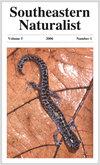Comparing Benthic Assemblages between Nocomis Nests and Ambient Substrate in South Carolina Streams
IF 0.6
4区 环境科学与生态学
Q4 BIODIVERSITY CONSERVATION
引用次数: 1
Abstract
Abstract - Ecosystem engineers modify instream habitat to the benefit or detriment of other species. Nocomis leptocephalus (Bluehead Chub) is a widespread minnow (Actinopterygii: Leuciscidae) native to small- to medium-sized streams in the Atlantic slope of the southeastern United States. By constructing large gravel-mound nests in pools for spawning, Bluehead Chubs are common ecosystem engineers that transport and concentrate gravel to form unique structures on the benthoscape. These nests are occupied by a diversity of benthic taxa and can persist up to 6 months before being destroyed by winter floods. In this study, we surveyed benthic assemblages occurring on chub nests and a similar volume of paired ambient substrate, and identified individuals to the genus or family level. Mixed-effects models indicated that overall counts, taxa richness, and Shannon diversity of benthic assemblages were similar between nests and ambient substrate. However, canonical correspondence analysis revealed differences in taxonomic composition between nests and ambient substrate. Several riffle-associated taxa occurred uniquely in chub nests, while many other taxa were found only in paired samples. Understanding the temporal and spatial scales at which the chub nest –insect interaction is relevant will be important for identifying the role of ecosystem engineering by chubs for structuring benthic assemblages.比较南卡罗莱纳溪流中Nocomis巢穴和环境基质之间的底栖生物组合
摘要:生态系统工程师通过改变河流栖息地来造福或损害其他物种。蓝头鱼(Nocomis leptocephalus)是一种分布广泛的鲦鱼(放线鱼科:淡水鱼科),原产于美国东南部大西洋斜坡的中小型溪流中。蓝头鲈鱼是一种常见的生态系统工程师,通过在池塘里建造大型的砾石丘巢穴来产卵,它们将砾石运输和浓缩,在底栖环境中形成独特的结构。这些巢穴被各种底栖动物占据,在被冬季洪水摧毁之前可以持续长达6个月。在这项研究中,我们调查了发生在丘贝巢穴和相似体积的配对环境基质上的底栖生物组合,并确定了属或科水平的个体。混合效应模型表明,巢与环境基质间底栖生物群落的总数、类群丰富度和Shannon多样性相似。然而,典型对应分析显示巢与环境基质之间的分类组成存在差异。一些与条纹相关的分类群只在弓形虫巢中出现,而许多其他分类群只在成对样本中发现。了解弓形虫巢-昆虫相互作用相关的时间和空间尺度,对于确定弓形虫生态系统工程在构建底栖生物群落中的作用至关重要。
本文章由计算机程序翻译,如有差异,请以英文原文为准。
求助全文
约1分钟内获得全文
求助全文
来源期刊

Southeastern Naturalist
环境科学-生态学
CiteScore
1.20
自引率
16.70%
发文量
31
审稿时长
18-36 weeks
期刊介绍:
The Southeastern Naturalist covers all aspects of the natural history sciences of terrestrial, freshwater, and marine organisms and the environments of the southeastern portion of North America, roughly bounded from North Carolina south to Florida, west to Texas, north to Oklahoma, and east back to North Carolina. Manuscripts based on field studies outside of this region that provide information on species within this region may be considered at the Editor’s discretion.
 求助内容:
求助内容: 应助结果提醒方式:
应助结果提醒方式:


